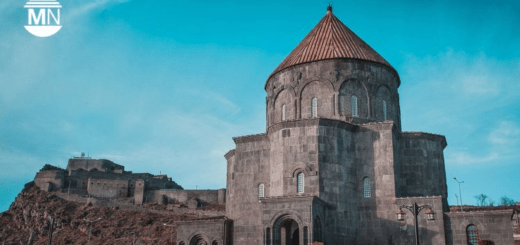Armenia’s Struggle to Free Its Bears

by Ani Hovhannisyan
For years, Bolik lived in a rusty cage near an auto repair shop in one of Yerevan’s neighborhoods. The concrete floor of the cage destroyed his paws, and because of poor nutrition, his teeth were severely damaged. Besides having physical wounds, Bolik was also traumatized psychologically – frightened and panicked. His owner claimed to treat him like a family member, but in reality Bolik’s life was one of neglect.
One might think that Bolik is a domestic animal like a dog or a rabbit, but he is actually a brown bear registered in Armenia’s Red Book of Animals, the national list of endangered species.
The reality of captivity came into sharp focus earlier this year, when The Foundation for the Preservation of Wildlife and Cultural Assets and the UK-based charity International Animal Rescue freed three Syrian brown bears – Aram, Nairi, and their cub, Lola – from a residential backyard in Yerevan. The bears had been confined for years in filthy metal cages, deprived of basic care, and fed inappropriate food, including cola.
From Armenia’s capital to its more remote corners, brown bears live behind bars – in restaurants, resorts, and private areas. Despite wildlife protection laws, experts estimate that as many as thirty bears remain in illegal captivity across the country.
Life in Captivity
“In Armenia an estimated 20 to 30 bears are kept in private captivity. Some are symbols of pride, sources of income, others tourist attractions,” says Ruben Khachartyan, the director of the Foundation for the Preservation of Wildlife and Cultural Assets. Despite an Armenian law aimed at protecting wildlife, he says, the problem has remained unsolved for more than 10 years.
Many of the bears are called Masha or Misha – sometimes Bulik or Bolik. It is impossible to release bears back into the wild because once they reach a certain age they are used to human interference. They must be taken young and raised in a special way – isolated from people and other smells – so that they do not get used to humans or livestock. They must have no direct interaction with people, and learn to find food on their own, to hunt naturally.
“To love an animal does not mean just seeing it and feeding it,” says a veterinarian working in the animal shelter at the Foundation for the Preservation of Wildlife and Cultural Assets. “Loving an animal, in my view, means creating proper conditions for it, an environment where the animal can live its natural life.”
For people outside Armenia, Bolik’s story may seem distant, but it speaks to a global challenge: how humans and wildlife coexist in a shrinking natural world. The fate of the Caucasian brown bear is not just an Armenian issue – it is part of the region’s biodiversity that connects to broader ecosystems across the Caucasus and beyond.
Azerbaijan has seen some success in its conservation efforts, removing the brown bear from the country’s Red Book due to a recovering population. In Turkey, the brown bear is a protected species, yet conflicts with humans are prevalent and often driven by increased human presence in protected areas, according to one study.
Bears and Villagers in Conflict
Beyond the cages, Armenia also faces a parallel challenge – wild bears losing habitat and coming into closer contact with humans.
Regulations are also weak on the other side of the conflict, where wild bears in search of food are entering villages nearby. In villages like Shatin, residents have faced bear attacks for decades, and the issue is only increasing. Villagers report significant damages: beehives destroyed, valuable livestock like chickens and sheep killed, and daily life disrupted by fear. Bears are becoming bolder, entering villages even during daylight and showing less fear of humans. Ultimately this is the consequences of human intervention and reduction of forest mass.
“As soon as the sun sets and it gets a bit dark, I don’t risk it anymore. I don’t even go to my workplace, because just ten meters away, on a rock, a bear could be sitting there,” says Hovhannes, who lives in Shatin.
“Even if you leave the lights on, it’s even better for the bear. It sees there’s no danger,” says Arman from Horbategh. “The bad thing is that it doesn’t just take any beehive – it chooses the best ones. It checks them: if it’s light, it leaves it, if it’s heavy, it takes it. So now it’s adapted and it doesn’t even seem to see danger anymore.”
From Policy to Practice
Since 2024, Armenia’s Ministry of Environment has partnered with the Darwin Initiative to launch a comprehensive program, “Mitigating Human-Wildlife Conflict Aggravated by Climate Change in Armenia,” funded by the UK government. This collaboration includes environmental education sessions and specialized courses on bear behavior, the causes of bear attacks, and methods to reduce human-bear encounters.
In May, the Foundation for the Preservation of Wildlife and Cultural Assets distributed professional beekeeping equipment to 30 beginner beekeepers in Yeghegis. This initiative is part of the Darwin Initiative program. The foundation also conducted various courses to deepen general environmental knowledge and to provide a more targeted approach with regard to bears by explaining the causes behind bear attacks and their behavior.
“We also carried out a social analysis and discovered that incidents of bears approaching humans often intensify due to the lack of knowledge among people,” says Gegham Margaryan, head of the Department of Agriculture and Environmental Protection.
Although new government programs and conservation efforts bring hope, their success depends not only on local action but also on awareness and responsibility beyond Armenia’s borders. Each choice, whether by a villager protecting livestock, a business owner displaying a bear for pride, or a tourist deciding not to pose with a captive animal, shapes the future of these bears. Ensuring that Armenia’s brown bears can live as they were meant to – in the forest, not in cages – requires a shared commitment to coexistence, compassion, and conservation.





